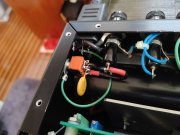I am posting this picture of a Customer's PL400 Series II (with his permission). I am quite proud of myself for this work. He said no holes in the chassis, but would allow one for a chassis (Earth) ground. I expanded it slightly and installed a 12 Amp miniature Raytheon switch, from the Space Shuttle, to be his power switch; with the ground wire riding piggy back on the top of the switch (the paint was sanded off the inside of the chassis for a metal to metal contact). The AC leads were kept short, the switch is protected by an AC-rated (X1 for 440VAC and Y2 for 300VAC) ceramic capacitor, the ground wire is kept long so it is the last wire to be yanked out of the chassis in case the amplifier falls and the plug does not slide out of the IEC jack, and finally all the Line connections go to the tips of the fuse holders and the Load connections go to the sleeve or shell of the fuse holders.


